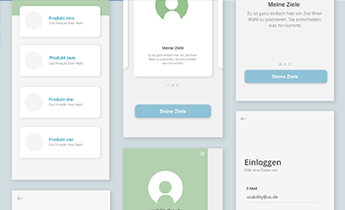Eye Tracking
Eye tracking or gaze tracking is a scientific method for capturing a person’s eye gaze. Eye tracking can be used to evaluate interactive applications, mobile applications or interactive products.

Our approach to Eye Tracking
Eye tracking is a valuable instrument to measure in which sequence and how long users look at certain parts in a user interface. That way eye tracking helps to identify which elements catch the users’ attention and which are ignored altogether. Before carrying out an eye tracking study we support you in formulating specific research questions and examine whether these questions can be answered with eye tracking.
Usability Test with Eye Tracking
Eye tracking is especially powerful when it is used in combination with a traditional usability test. While the test participant is working on a realistic work task, such as ordering a product, we capture the user’s eye gaze with our eye tracker. That way we are collecting the users’ statements and objective eye gaze data. Both, the qualitative and the quantitative results are analyzed by our experts.
What can we test with Eye Tracking?
Our modern eye tracking systems enable us to test almost every interactive interface. Eye tracking tests are possible for:
-
Websites
Web Portals, Online Shops, Web Apps, Intranet, ...
-
Interactive Kiosks
Terminals, Vending Machines, POS, ...
-
Online Shops
Store pages, product pages, ...
-
Software
Applications, Games, ...
-
Mobile
Apps, Tablets, Smartphones, E-Reader, ...
-
Marketing tools
Landingpages, online magazines, ...
Eye Tracking Results
Heatmaps

Heatmaps visualize how long or how often certain elements were looked at. Warm colors like red and yellow indicate areas which were looked at longer or which attracted more fixations.
What can we find out with Eye Tracking?
- Which elements on my website are being noticed by the users and which are ignored altogether?
- Which elements distract the users from the parts that are actually important?
- Which content elements are being read and which are only scanned?
- How long and how often do users look at certain elements (menu, navigation, advertisement) in an interface?
- In which sequence do users perceive elements in an interface?
- Does the site's structure enable users to find required information without having to search extensively?
When do we recommend Eye Tracking?
Pictures, colors and design have a huge influence on the human perception. That is why eye tracking studies should only be carried out when first graphical designs are available.
Great results can also be achieved by combining eye tracking and usability testing. While representative users work on realistic work tasks, we are able to observe their gaze patterns and analyze decision making and perception processes in detail.
-
Detect visual attention
Eye tracking can reveal where a user's attention is focused while performing a specific task.
-
Answer qualitative questions
Eye tracking can contribute to answering qualitative research questions by allowing a better understanding of the user's actions.
-
Live observation possible
You can observe live how your users perceive your system - in our lab or livestream.
What are the results?
You will receive a comprehensive report with a description of the usability problems and specific recommendations for improvement. A highlight video and a workshop are also part of the results.
Usability Report

After a usability test in which eye tracking was used, all results are provided in a structured report. This report contains descriptions of the usability problems and supplementary eye tracking observations. If needed we illustrate the optimal solution with best practice examples or develop custom designs that help you fix the problem.
Enlarge report example
Highlight Video

The highlight video shows your users in action: Key scenes from the test sessions illustrate critical usability problems. The test participants’ eye movements are visualized by a red dot. That way, you are able to experience your product through your users’ eyes and observe which elements catch their attention and which are ignored completely.
Workshop

We present the results and the highlight video in front of all project stakeholders and discuss possible solutions. If technical or internal restrictions prevent a 1:1 implementation of our recommendations, we will find a compromise during the workshop that makes everyone happy: project managers, marketers, developers and most important – your users.
Which technology do we use for Eye Tracking?
To evaluate screen based applications we use remote eye tracking systems manufactured by Tobii Technology, the world leader in eye tracking technology.
The eye tracking system is integrated into a regular computer screen. That way, we are able to create a natural, unobtrusive testing environment. After a short 10 second calibration the test participants do not even notice that their eye movements are tracked.

Client voices about Eye Tracking
Other interesting usability methods
All methodsHow do I profit from good usability?
-
Satisfied customers and users
Higher customer loyalty, reduced bounce rates
-
Better product quality
Easy to use products, reduced errors
-
Increased revenue and profit
Conversion rate optimization
-
Increased productivity
Employees, working efficiency, less operation errors
-
Decreased development time and costs
More agile processes, avoidance of failing products
-
Decreased support & training costs
Intuitive-to-use products that do not require any training
-
Win new customers by reducing exit rates
Reduced bounce rate through landing page optimization
-
User Experience as a positive product feature
Competitive differentiation





 Usability Testing
Usability Testing Contextual Inquiries
Contextual Inquiries Expert Review
Expert Review Prototyping
Prototyping